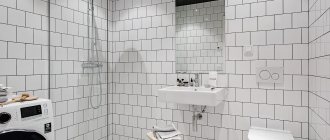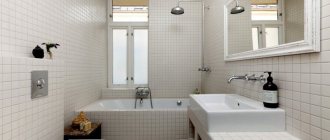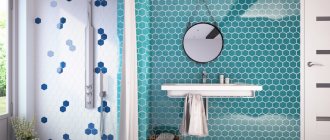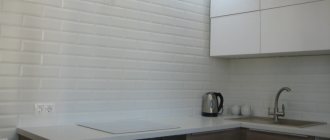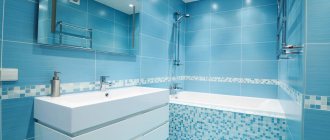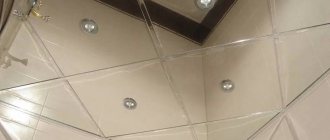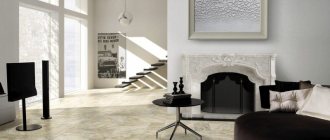Beauty, as we know, lies in simplicity. Simple things are also good because they don’t get boring, don’t lose their relevance and are easy to combine. All of the above is true for white tiles. A simple white finish is classic, solid and very versatile. White tiles will never go out of style. If the interior gets boring, you can always revive and diversify it with colored or neutral decor. The white background color will not conflict with it.
In connection with white tiles, the question of grout color often arises. Should it be pure white or can it be colored? Is it permissible to use dark compounds?
Let's start with the fact that the seams are usually made either in the color of the tiles, or in maximum contrast. This applies to any tile, not just white.
Tone-on-tone seams
Contrast seams
Highly contrasting means not being slightly different, but clearly standing out. It is not customary to grout the seams of white tiles with pale gray, cream, or beige compounds. Why? It's simple: if the contrast is minimal, the seams will appear dirty, making the surface look rather untidy.
So, the most common are three grout options for white tiles: - tone on tone with tiles; - gray; - black.
The use of bright colored grout is also possible. But this is a rather bold decision, and not for everyone. The colored seams are too conspicuous. They make any styling errors and manifestations of asymmetry noticeable.
Of course, the choice of colored grout must be dictated by something. Tile seams on the wall can repeat the color of porcelain stoneware floor tiles, paint, furniture elements, etc.
It is worth admitting that sometimes it looks quite interesting due to some playfulness and frivolity.
However, we started the article by talking about how simple (that is, natural, modest and unpretentious) things do not get boring for a long time. White tiles with colored joints are not one of these. When making repairs for many years, try to give preference to more traditional and universal solutions.
Grout functions
In ceramic cladding, grout (or grout) is the same essential element as tiles. She is chosen simultaneously with the purchase of tiles, and the following tasks are assigned to her:
- Protection of tile joints and strengthening of masonry . Most types of grout absorb water and dirt to one degree or another, they also serve as a barrier between moisture and the glue on which the tile is held and preserve its structure from destruction.
- Maintaining hygiene . Grout is a barrier that prevents the development of mold on the seams.
Classic design of a small bathroom Source pinimg.com
- Masking defects . Using grout you can hide an unskilled seam or a small chip. The trick will only work if the grout was chosen to match the tile. In the case of contrasting combinations of materials, the master will need all his professionalism and accuracy.
- Changing the appearance of masonry . The greater the difference between the color of the ceramic and the fugue, the brighter the decorative effect will be and the more attention-grabbing the cladding will be. Dark grout looks especially bright on white tiles.
- Creating a Balanced Design . To make a bathroom or kitchen look complete, the color of the grout mixture is selected to match the tone of any element (for example, furniture).
Contrast gives space clarity Source alumdevelop.ru
Tile
0 votes
+
Vote for!
—
Vote against!
Laying tiles in the bathroom or kitchen is an integral stage of a major renovation, which every person encounters no more than once or twice during the entire period of living in an apartment. In this regard, the master must be aware of the entire burden of responsibility placed on his shoulders and treat each stage of repair with the utmost care, thinking through every little detail. Laying ceramic tiles is considered one of the most difficult types of renovation and finishing work, during which it is also important to pay attention to detail. It would seem that after laying the tiles, it’s time to relax, but at this stage, most craftsmen are just beginning to think about the question: “How to choose grout by color?”, and losing vigilance at this moment can lead to irreparable consequences. When choosing a grout for a tile, it is important not only to know its composition, but also to decide on its color, which will give the wall a finished and harmonious look, and the composition - integrity. In addition, it is important to take into account many factors - the microclimate in the room, the moisture resistance of the composition, as well as its resistance to fungal and mold damage. Based on this, it becomes clear that the correct selection of grout for tiles is a rather complex process, the results of which largely determine the decorativeness of the finished surface and the integrity of its perception. To make this task easier, in this article we will look at the main types of grout, and advice from professionals on choosing the color of grout will help you make the right choice.
Content
- What is tile grout: the main functions of grout mixtures
- Types of grout for tiles
- Basic principles for choosing grout: expert advice
- Basic effects created using grout
- Advice from experts on choosing grout for tiles
- What is universal grout?
- We tint the grout with our own hands: if the desired color is not on sale
- Options for color combinations of tiles with grout
What is tile grout: the main functions of grout mixtures
If previously only cement mortar was used to seal the joints between tiles, today the construction market offers consumers a large number of different grouting compounds that not only reliably mask the gaps between the tiles, forming an airtight coating, but also transforms the appearance of the base material.
Grout for tile joints is a homogeneous dry or diluted to a paste mixture, for the manufacture of which polymers are used, as well as white or gray cement. There are certain features of the production of one or another group of grout mixtures - some of them are made only in white and gray colors, and tint dyes are added to them only before starting work, others are produced in ready-made color options.
What is tile grout used for?
By filling the tile joint, tile grout protects the joints from the penetration of moisture and dirt into them and thereby prevents the destruction of the adhesive composition. Due to this, moisture is not absorbed into the wall, and the likelihood of mold and mildew forming on it is minimized;
Using tile grout that matches the color of the tile, you can hide cladding defects, such as uneven joints and chips;
Tile grout allows you to combine disparate tile elements into a single picture, and, serving as the final touch, gives it a feeling of completeness;
If you are not a connoisseur of pastel colors in the interior and want to give it expressiveness, use tile grout in contrasting shades. Thanks to this technique, you will emphasize the geometry of the picture, making it deeper and richer;
Using tile grout, you can combine disparate elements of the interior and thereby create a holistic composition, which is especially important if various pieces of furniture and cladding “argue” with tiles of contrasting color.
Types of grout for tiles
Before we talk about how to choose grout for tiles in the kitchen, we will consider the main types of grout, taking into account their composition. Depending on the composition, the following groups of grout for tile joints are distinguished:
Cement-based grout, the composition of which may vary slightly depending on the inclusion of one or another component (modifying, polymer additives), is the most common option on the construction market. Despite slight differences in composition, they can be used when working with tiles of different colors and qualities. As a basis for cement grout, either a cement-sand mixture or a special type of cement, Portland cement, can be used. The disadvantages of cement-based grouts are a limited range of colors, most often represented in shades of white and gray, and low resistance to moisture;
Grout is based on epoxy resins, the distinctive feature of which is the presence of a hardener in the composition, which ensures long-term preservation of the color of the grout. Due to the fact that applying epoxy grouts requires certain skills and experience, they are rarely used in the process of renovating typical apartments;
Grout in the form of silicone sealant, characterized by ease of use and a variety of colors, making it easy to choose a grout for tiles of any color and texture. This grout is resistant to high humidity, as well as mold and other fungal infections, which is due to the presence of antifungal components in the grout.
Important! Experts do not recommend using silicone sealant as a grout, since the latter, in contact with moisture during operation, turns yellow and also shrinks significantly. If you still prefer a sealant as a grout, choose polyurethane compounds, but remember that they do not have a variety of colors and are produced mainly in monochrome.
Basic principles for choosing grout: expert advice
Basic effects created using grout
The correctly chosen grout color directly determines the appearance of the room for which ceramic tiles are used, its integrity and visual perception. There are a number of rules that must be followed when choosing grout.
To facilitate the process of choosing grout, the designers divided all possible effects created by combining tiles and grout into several groups. By giving preference to one or another visual effect, you will facilitate the process of choosing grout and creating an interior concept.
Let's look at each of the three options for effects that can be created by choosing the right grout color options.
- Imitating a single surface is a technique that can be implemented if you choose a grout of the same color as the ceramic tile. By giving preference to this effect, you can visually expand the room, which will become especially relevant for small bathrooms in standard apartments;
- Highlighting tiled elements using grout of a contrasting color is a technique that involves using a grout mixture of a contrasting shade with the tile. This technique is considered one of the most effective, especially in cases where tiles of bright colors or non-standard shapes are used, which can be emphasized by giving preference to contrasting grout colors;
- Selecting a grout mixture to match one of the shades of the tile is a technique through which you can not only create a holistic composition, but also unobtrusively indicate the geometry and shade of the tile. By adopting this effect, you will create a calm atmosphere in the room, devoid of unnecessary expressiveness.
Advice from experts on choosing grout for tiles
Specialists with extensive experience in interior design share some nuances and secrets that will help you achieve the desired effect in your interior.
Let's look at some of them:
- Using light colors of tiles and grout, you can visually expand the room;
- By giving preference to dark tiles and grout of the same color, you can unify the room, but the use of dark tones in the interior of the room will help to visually reduce it;
- Using light tiles together with grout of a contrasting dark shade will divide the wall into separate segments. This is an original effect that will be an ideal complement to certain areas of the interior;
- If, in the process of finishing a small room, you use tiles whose colors include several shades, choose a grout whose color is close to the lightest shade in the tile pattern;
- If you use mosaic tiles to decorate walls or horizontal surfaces, give preference to grout in calm shades, for example, beige or light gray;
- Among colored grouts, the most universal is white grout. Thanks to this property, it can emphasize or disguise the boundaries between tiled elements. However, experts do not recommend using white grout to finish the floor, as it will soon lose its original appearance and acquire an unattractive dirty gray shade. To avoid this, to finish horizontal surfaces, use grout that matches the tone of the tile or a shade that is closest to the color of the tile;
- When decorating small rooms, experts recommend not using more than three shades of tiles, and therefore, grout mixtures. Otherwise, the color scheme of the room will be chaotic and disjointed, which will make the room visually more cramped.
- When we choose the color of grout for the bathroom, we often try to choose a shade that is as close as possible to the color of the tiles, but today, a wide variety of color solutions for tiles and grout adds other, often contrasting color combinations to the designer’s arsenal.
Important! Today, manufacturers present collections of tiles, to which grout colors have already been selected. As a rule, these color combinations are as original as possible: black tiles are complemented with pearl-white grout, beige with milk chocolate or cocoa-colored grout, olive with graphite grout, and gray with mahogany-colored grout.
If earlier the presence of good taste could be demonstrated by choosing grout in neutral shades, today the situation is the opposite, and when finishing a bathroom, experts recommend using grout in bright colors - red, green, orange, turquoise, etc. shades. This advice will be especially relevant if you have chosen white tiles, since all colors are combined with it. However, if you combine white tiles with brightly colored grout, try to choose it in such a way that it matches the color of the furniture or other interior elements as much as possible.
What is universal grout?
Contrary to popular belief, white grout is not universal. Despite the fact that it harmonizes with materials of any color, together with tiles of dark shades it forms contrasting combinations that do not fit into the framework of classic interior concepts.
The modern construction market offers an alternative to white grout - colorless grout made from epoxy resin with the addition of glass. The versatility of the grout is ensured by its light-absorbing characteristics, due to which it becomes colorless. It is often called a “chameleon” due to its ability to adapt to the color of ceramic tiles.
Important! Colorless grout is a universal material produced using innovative technologies. It is highly wear-resistant, easy to apply and also easy to clean. Chameleon grout is characterized by resistance to mechanical and chemical influences, and high resistance to mold and other fungal infections.
Colorless grout is indispensable when working with various types of glass mosaics and in the process of creating tile panels.
We tint the grout with our own hands: if the desired color is not on sale
Often, even in large construction supermarkets, it is not always possible to find grout of the desired shade, since the modern manufacturer does not cover the entire color palette. If you were unable to find the desired color of grout, do not rush to abandon your original decision and choose a different shade. You can solve the problem by choosing a color scheme of a suitable shade.
In this case, you have the following options:
- Using a special tinting paste;
- Purchasing a regular water-soluble color;
- Use gouache or watercolor as a tinting color.
Using any of these components, you can paint white grout any color you want or make the shade of the grout more saturated.
Important! If you are planning to tint the grout, remember two important nuances:
- Try to paint the grout in one day. Otherwise, the grout will dry out, and you are unlikely to be able to find the desired shade the next day;
- Remember that after drying the grout becomes lighter, therefore, it is necessary to use a color that is several tones darker than planned.
Options for color combinations of tiles with grout
Experienced craftsmen know that even after applying a color sample of grout to the tile, it is quite difficult to imagine how they will look together on the surface. In this regard, before you begin finishing the surface, study photos of interiors illustrating typical combinations.
Using multiple colors of grout
The example illustrates the option of using grout of two colors - white and red. This option will be relevant if you are using tiles of several contrasting shades, and to create a single plane and a harmonious transition between shades, you need to choose a grout to match the tile.
The surface, for the finishing of which monochromatic tiles were used, looks like a single plane, and only the presence of a small relief makes it possible to distinguish individual segments in it. The effect of a single plane is achieved through the use of grout, the tone of which is ideally matched to the color of the tile. However, the ideal fusion of materials depends not only on the color, but also on the composition of the grout used. For example, the surface of epoxy grout after hardening has noticeable similarities to the glazed surface of ceramic tiles.
To harmonize the transition from white to colored segments, white grout is used, which focuses on the contrast between light and dark shades.
Thanks to this technique, the interior looks thought out to the smallest detail. For example, a tile with a photo pattern, located between a white and a red tile, has shades in its color scheme that are similar to the colors of the surrounding tile. Due to this, despite the abundance of color shades, the composition retains its integrity and original appearance.
Using grout similar in tone to the tiles
If you do not plan to add expressive notes to the interior, and, on the contrary, want your eyes to rest when looking at the surfaces of calm shades, give preference to this option. Thanks to this technique, the wall covering will also look uniform, and, at the same time, the seams between the tiles will emphasize the origin of the material.
Selecting grout and tiles of the same shades
This option will be most preferable if you plan to create the most uniform plane possible. The option proposed below illustrates how you can combine individual planes that divide the wall surface into two parts - the upper decorative and the lower panel.
The wall is divided using a border tape, the design of which includes bright inclusions. Despite the fact that they are radically different from the main color scheme, they are designed to enliven the interior and create a holistic composition. To eliminate possible randomness and fragmentation of the plane, it is necessary to use grout, the tone of which is as close as possible to the tone of the tile.
Using grout and tiles in contrasting shades
This section presents two options for selecting contrasting materials. The first of them is classic and involves a combination of black and white colors. Thanks to this combination, a cold and restrained interior is created, which does not always find its admirers due to its excessive severity.
The following example also illustrates a contrasting, but more cheerful color combination. Contrasting white grout adds freshness to a room decorated with ultramarine tiles. This combination will be ideal for decorating a bathroom and creating an optimistic mood.
Choosing grout for tiles video
Types of grout
Color is not the only indicator by which a grout mixture is selected. Manufacturers offer several types of materials, and their features also need to be taken into account. All of them perform a protective and decorative function, but they manifest themselves differently in operation. The seams on the tiles are grouted using the following compounds:
- Based on cement mixtures . A grout consisting of cement and additives (for example, liquid latex) is suitable for sealing joints with a thickness of 1-5 mm; it is elastic and dries quickly. A mixture with added sand is intended for wider joints. It can be white or gray, different compositions vary in grain size.
Large format tiles with contrasting seams Source thespruce.com
- Epoxy mixtures . The composition includes epoxy resin, coloring pigment and hardener, which makes the coating dense, moisture-resistant and, importantly, resistant to household chemicals and ultraviolet radiation. Grout is used for wide (more than 6 mm) joints. Mixtures with the addition of cement are produced; their properties lack chemical stability.
- Silicone . Silicone-based materials are elastic and do not shrink after drying. However, it is better to use them as an additive, since their main property is that they are sealants that protect the base from water. They are not cheap and are suitable for use in wide joints.
Using ceramics of different shapes Source pinimg.com
How to process seams?
To mash, you will need a special rubber spatula. The algorithm of actions is presented in the following stages.
- At the beginning of work, it is necessary to prepare the working material. To do this, add a small amount of water to the purchased putty. After which the resulting substance should be mixed until a homogeneous mass appears. After a few minutes the mixture is ready for use.
- Before applying the paste between the slabs, you should make sure that there are no foreign substances in them. If you find remains of building materials or glue, they must be removed immediately. The putty is applied using a spatula to the space between the slabs. After this, using smoothing movements, the substance is pressed into the hollow space.
- Then you need to remove the excess paste remaining on the surface of the tile. For cleaning, it is convenient to use a foam sponge or cotton rag. Particular attention should be paid to removing traces of material when using a dark grout. Otherwise, it will harden, and unaesthetic stains will remain on the surface of the light tile. Therefore, any remaining material must be removed as soon as possible.
Grouting the tiles should be carried out following the manufacturer's recommendations.
After the grout has dried, you need to check the quality of the resulting joints. At the end of work, it is advisable to ventilate the room.
Pros and cons of dark seams
Contrasting combinations of tiles and fugues are an expressive means of interior design. Before choosing one or another combination, it is useful to get acquainted with the advantages and disadvantages of dark-colored seams. Black seams on a white background have the following advantages:
- They attract attention to the decoration, set the mood for the design, and look appropriate in many modern styles (for example, Scandinavian).
- They give the walls a presentable, more austere look. They always look neat and elegant.
Design in Scandinavian style Source pinimg.com
See also: Catalog of companies that specialize in finishing materials and related work
- In many interiors, contrasting design looks unexpected and therefore original.
The white and black finish has the following disadvantages:
- It will not fit into every interior.
- Although light materials have the ability to visually enlarge a space, the combination may seem overly gloomy.
- If there are errors in the cladding, they will not go unnoticed.
Multi-format tiles are united by grout color Source pinimg.com
Color combination options
Thanks to well-chosen color combinations, you can get three options for effects:
- One color. It is the simplest tandem, which is a single whole. A one-color combination is perfect for those who like a laconic, not too catchy design, and also allows you to mask some finishing imperfections in the form of uneven joints or chips.
- Contrasting grout. Gives the environment a special expressiveness and favorably emphasizes the geometry and laying of tile elements, giving them a deeper and richer look.
- Shades. Using this solution, you can unobtrusively highlight the geometric shape, pattern and color of the cladding, thereby creating a calm, expressive design.
The photo shows a bathroom interior with contrasting grout for wall and floor tiles.
Currently, there are collections of tiled models that already have a tinted putty solution. Most often, such a color palette is particularly original, for example, a black finish is complemented by a pearl-white fugue, a beige finish is complemented by grout in chocolate tones, and an olive finish is complemented by graphite.
How to choose a color combination
White tiles are a versatile material that never goes out of style. If it seems boring, you can diversify and complicate the design by grouting. Whatever color of grout you choose, the background white color will not conflict with it. When choosing a grout shade for white tiles, it is useful to take into account the following notes:
- The contrasting combination, white tiles with black joints, fits into modern styles: Scandinavian, loft, modern. It is suitable for interiors that emphasize graphics, for example, pop art or eclecticism, for minimalist design.
Accent wall in the shower Source pinimg.com
- There are also restrictions on the choice of ceramics. A plain white material is ideal, but it may have a relief or a faded, as if faded, print. If the pattern is more saturated, the combination with contrasting seams will seem sloppy, loading the space.
- The emphasis on the tiles can be made using grout in gray shades, which combines well with almost all ornaments, patterns and prints.
- If it is necessary to emphasize the situation, choose white (sometimes light gray) grout. If you need to draw attention to the walls, the grout is made as dark or black as possible; it’s good if it matches the shade of the floor covering.
Light gray seams do not distract attention from the design Source tesser.ru
Rules for processing seams
People can apply regular grout with their own hands. But when choosing latex or epoxy materials, it is better to entrust the matter to a professional so as not to spoil the expensive product. The operating principle is as follows:
- Dilute the grout with water according to the instructions (if it was originally powder). Usually you need to stir the composition and wait a few minutes.
- Remove all dirt and excess objects from the seams. Apply the putty with a spatula (rubber) between the tiles and press in with smoothing movements.
- Clean the tiles from any remaining excess paste. To do this, use a damp sponge or cotton rag.
- Leave to dry, then check the strength of the seams and ventilate the room.
More detailed instructions can be seen in the video.
Grouting | How to joint tile seams
There is also one secret on how to apply fugue into the seams better.
Grouting floor tiles - a trick
Recommendations for using colors in the interior
It is customary to make tile seams in cladding of any color (not just white) either as contrasting as possible, or to match the tile. Black grout color is chosen if there are other black elements in the room (for example, a black floor in the bathroom or a black countertop in the kitchen).
Shades of gray have a softer effect on perception, they are more neutral and therefore multifunctional. Gray grout does not require the additional presence of gray in the interior. But, if it is duplicated, the design will look more elegant.
Gray fugue on a kitchen apron Source amazon.com
Most often, tiles can be found on the walls and floor of the bathroom or on the walls of the kitchen (often this is a “hog” in the finishing of the apron). But, for example, a bar counter made of white mosaic with black grout also looks beautiful. This detail fits organically into a modern interior.
Existing combinations of white and black (or gray) are used to achieve a specific aesthetic result. The combination of white tiles with white grout is used in the following cases:
- If the bathroom is small and you want to make it look larger.
Design with patchwork style details Source art-oboi.com.ua
Choosing between black and gray
It seems that the difference between black and gray is small, but in fact, it is very noticeable to the eye. Which grout should I choose?
Black is used only if there are other objects of this color in the kitchen, for example, a countertop. This rule also applies to the bathroom: black seams are only welcome if the color is found in the interior, for example, on the floor.
Otherwise, there is a possibility that the masonry will begin to stand out too much and “cut” the wall or floor.
Black and white grout options for hog tiles.
Gray color is considered more neutral and multifunctional, so its duplication in the interior is not necessary. But if it is made in the form of curtains or at least a set of dishes, then the interior will instantly become more stylish.
Briefly about the main thing
The choice of grout plays an important decorative role in creating the design of a kitchen or bathroom. Its color affects the perception of the tile, which is especially true for white tiles. There are different types of grout mixture, and their characteristics must be taken into account when choosing a material.
In the design of the bathroom and kitchen, combinations of white tiles with white, gray and black grout are used. Most often, the seams are made white; This is a classic, proven and attractive option. Gray joints will help soften the tile pattern or emphasize the original layout. The contrasting white and black option is difficult to ignore; it is used to create an accent in some styles.
Ratings 0
Other color options
Have you noticed that white tile joints are rarely done in pastel colors? For example, beige, light gray, cream.
This is due to the fact that such shades with little contrast to white from a distance will simply look like dirty stripes. The kitchen will become untidy and uncomfortable.
That is why three types of grout are most often used with white tiles:
- white;
- gray;
- black.
Designers allow the use of brighter colors to seal joints. But at the same time they warn that this is a bold step, and over time the seams may begin to become an eyesore. At the same time, brightness simply requires ideal masonry, as it highlights all the flaws and flaws.
Of course, the choice of a bright tone should be based on the colors that are already in the interior. At the same time, this will balance the design, give it cheerfulness and a bit of carelessness.
When choosing a dark grout for white tiles, the bias is primarily towards practicality. If aesthetics are important, then when choosing light colors for sealing joints, several nuances must be taken into account.
For example, dark grout lines always highlight the tiles, so if they have an unusual shape or are laid in an unusual way (for example, diagonally), then it is better to choose a contrasting grout.
Due to such highlighting, the practical meaning of a certain masonry is emphasized. For example, if the tile is narrow and lies vertically, the room will appear taller than it actually is. If there is no need for such effects, then you can stop at the white version.
Some owners are so categorical that they call dark seams on white tiles “dirt under their nails.” And for such, designers have found a way out - using dark blue or dark green mastic.
Such color combinations will cool the room and fill it with freshness. If you need to achieve the opposite effect - warmth, then it is better to look towards brown tones.
Urban style bathroom design
Urban style is rapidly gaining popularity. Bathrooms are no exception. To create a room in this manner, materials are used predominantly in white. This is the main distinguishing feature of this direction. Dark colors are also used, but much less frequently.
To create a bathroom in an urban style, you should use white materials
When creating an urban style, one should adhere to rigor and minimalism in all details. This also applies to the selection of tiles for the bathroom. It should be taken into account that dark tiles will create the effect of presence in an industrial enterprise, while white tiles will express simplicity in design.
When creating a design, you should adhere to rigor and minimalism
If the color is chosen incorrectly, you may get the impression of a reduced space. Therefore, if the size of the bathroom is quite modest, you should not settle for a dark option. White tiles, on the contrary, can create the illusion of increased space, but only if the lighting is properly organized.
If you plan the design incorrectly, the room may visually shrink
How can you decorate the walls?
We use resin-based grout
We should not forget that when renovating bathroom walls, the correct choice of grout color is no less important than the selection of other materials.
So, if its shade does not match the color of the tile and the general style of the interior, then even very expensive and beautiful tiles will look like the most ordinary ones.
On the other hand, if you manage to choose the right grout color for the tiles, then you will be able to solve the problem with minor inaccuracies made during its installation.
In addition, the right color can play the role of a kind of “frame” that will favorably emphasize the beauty of the tile itself.
For example, you were unable to choose the color of the tile that you would like, and you bought a more or less worthy replacement, in your opinion.
After laying these tiles without grouting, your walls will be boring and expressionless, and this, in turn, will leave an imprint on the entire interior.
When choosing the color of the grout material, do not forget about the main thing - if the color of the joints you choose has a lighter shade than the tile itself, then after installation such a wall will look solid, without visible transitions from one tile to another.
Otherwise, by choosing a darker shade of grout than the tile, you can create various geometric combinations in which each tile will clearly stand out from the whole picture.
If you decide to decorate the bathroom walls with a colorful panel of multi-colored mosaics or photo collages, then you should choose a transparent material for the seams.
Tone-on-tone grout with tiles may also work here, but there is not always a suitable shade for every tile color.
Immediately before use, the grout must be tested on a separate tile by applying a certain amount of the compound to it and waiting for it to dry.
If the picture you saw did not impress you, and you could not decide on the right color among the huge number of shades of tile putty, you can always choose white, which is suitable for any tile.
Choosing grout for tiles with different textures
For tiles imitating light wood, you can choose grey, beige, sand or milky putty; cladding imitating dark wood, such as wenge, combines perfectly with seams made in light shades.
Marbled products look harmonious with joints that have black, dark gray, white and even reddish tones. To maintain the interesting texture of the brick finish, special compositions with small fractions are selected.
